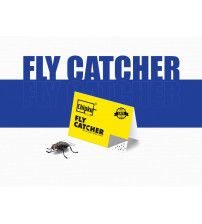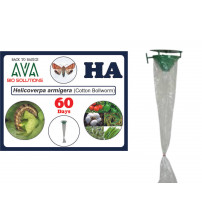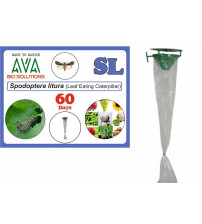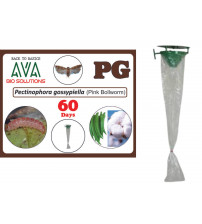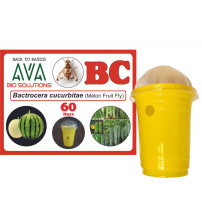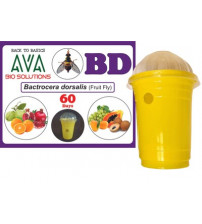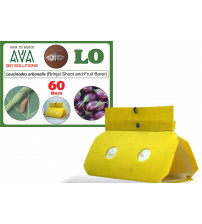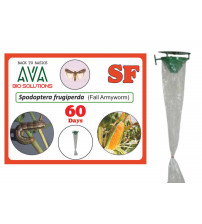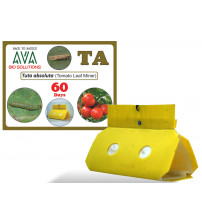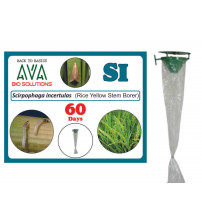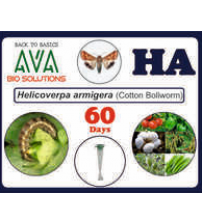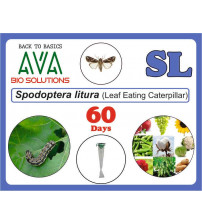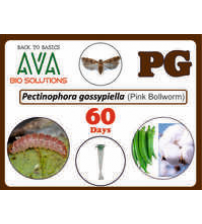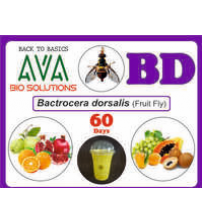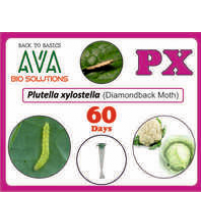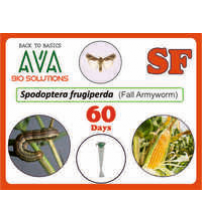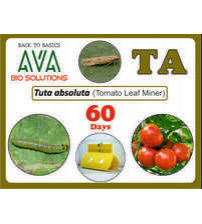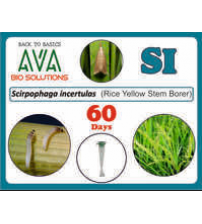Shopping Cart
0 item(s) - Rs 0.00Ava Combo Pack of Delta Trap + PX Lure
Brand: Ava Bio Solutions
Categories: Insects Traps, Pheromone Lures & Traps,
Availability: In Stock
Cash on delivery Availability: NO
Ava Combo Pack of Delta Trap + Plutella Xylostella (PX) Lure of Diamondback Moth
Description:
Pheromone Lure of Diamondback Moth (Plutella xylostella)
Target Crops: Cabbage, Cauliflower
Trap to be used: Funnel Trap
Number of traps per Acre: 10 - 12
Life of Lure: 60 Days
Diamondback Moth (Plutella xylostella):
Identification:
A fully-grown larva is 10 mm long. The head capsule is pale to pale greenish or pale brown, mottled with brownish and black-brown spots. The eye spot is black. The body is green, sometimes tinged with pale yellow with distinct body segments, and bears a few short hairs, marked by the presence of small white patches. The larva has five pairs of prolegs; a pair of prolegs protrudes from the posterior end forming a distinctive 'V' shape.
The adult is grayish brown with a 9-mm-long body and a wingspan of about 12-15 mm. In males, the upper two-thirds of forewings is light fuscous, sometimes partially ochre-tinged; sometimes mixed with whitish scales, and flecked with scanty small blackish dots. The lower one-third of the forewings is ochreous-white, the upper edge being nearly white, margined broadly with dark brown or black-brown. In females, the upper two-thirds of the forewing is light ochreous or light grey-ochreous, the contrast not so pronounced between upper and lower portions in coloration, but the markings are like those of males. When wings are folded, three or four diamond-shaped areas formed by forewings are visible on the dorsal side when the moth is at rest; hence the common name 'diamondback moth' gives details of wing venation and genitalia. The moths are weak fliers and can disperse, on average, only 13-35 m within a crop field. They are readily carried by the wind and can travel long distances, at 400-500 km per night.
Life Cycle:
The rate of development of larvae is temperature-dependent. There are 4 larval stages (instars). Caterpillars are active, slender, green worms with microscopic hairs. The larval period varies from 6 to 30 days. On young cabbage and on watercress, early larval instars migrate to the growing point and cause extensive feeding injury. The damage caused by the larvae feeding is often very severe and in most areas, good quality cabbages cannot be grown unless the insect is controlled. Adults are small, grayish moths, approximately 1/3 inch in length. When the wings are folded, the moths have a line of three diamond-shaped markings that occur along the middle of the back. Males and females are the same size.
Females live from 7 to 47 days and males live from 3 to 58 days. The number of eggs laid per female may range from 18 to 356. Oviposition normally begins on the day of emergence lasting about 10 days. The number of eggs produced by a single female is influenced by photoperiod, temperature, and age or condition of larval food.
Nature of Damage:
Plant damage is caused by larval feeding. Although the larvae are very small, they can be quite numerous, resulting in the complete removal of foliar tissue except for the leaf veins. This is particularly damaging to seedlings and may disrupt head formation in cabbage and cauliflower. The presence of larvae in florets can result in complete rejection of produce, even if the level of plant tissue removal is insignificant. Larvae may also feed on other portions of the plant. Mature larvae feed on the florets of cauliflower and bore into cabbage heads. If larvae feed on the inner leaves of young cabbage plants before the heading stage the cabbage plant develops several deformed and unmarketable heads.
Manufactured, Marketed, and Dispatched by: Ava Bio Solutions
Barrix Catch Fruit Fly Lure
Rs 79.00
Min. Quantity: 6
Barrix Catch Fruit Fly Lure Click here to see Organic Certificates of Barrix (Trap) De.....
Barrix Catch Vegetable Fly Lure
Rs 79.00
Min. Quantity: 6
Barrix Catch Vegetable Fly Lure Click here to see Organic Certificates of Barrix (Trap) .....
Barrix Catch Housefly Lure
Rs 159.00
Min. Quantity: 5
Barrix Catch Housefly Lure Description: Contains highly pure para-pheromones. Kairo / Phe.....
Melon Fly Lure
Rs 60.00
Min. Quantity: 10
Melon Fly Lure Control: Bactrocera Cucurbitae Description: Host Crop: All Vegetables crops. Me.....
Fruit Fly Lure
Rs 60.00
Min. Quantity: 10
Fruit Fly Lure Controls: Bactrocera Correcta ( Guava Fruit Fly) Bactrocera Zonata ( .....
Helic - o - Lure / Helicoverpa Armigera Pheromone Lure
Rs 23.00
Min. Quantity: 10
Helic - o - Lure / Helicoverpa Armigera Pheromone Lure Control: Helicoverpa armigera (cotton Boll.....
YSB Lure / Scirpophaga Incertulas Pheromone Lure
Rs 23.00
Min. Quantity: 10
YSB Lure / Scirpophaga Incertulas Pheromone Lure Control: Scirpophaga Incertulas (Yellow Steam Bo.....
Brinjal Pheromone Lure for Brinjal Fruit & Shoot Borer
Rs 40.00
Min. Quantity: 10
Brinjal Pheromone Lure / Leucinodes Orbonalis Pheromone Lure Brinjal Pheromone Lure for Brinja.....
Tu - Tom Lure / Tuta Absoluta Pheromone Lure
Rs 45.00
Min. Quantity: 10
Tu - Tom Lure / Tuta Absoluta Pheromone Lure Control: Tuta Abosulta (Tomato Leafminer) Descri.....
Gulabi Fly Lure / Pectinophora Gossypiella Pheromone Lure
Rs 25.00
Min. Quantity: 10
Gulabi Fly Lure / Pectinophora Gossypiella Pheromone Lure Control: Pectinophora Gossypiella (Pin.....
FAW Lure / Spodoptera Frugiperda Pheromone Lure
Rs 35.00
Min. Quantity: 10
FAW Lure / Spodoptera Frugiperda Pheromone Lure Control: Spodoptera Frugiperda Description: .....
Combo Pack of Max Plus Pheromone Trap + Melon Fly Pheromone Lure
Rs 179.00
Min. Quantity: 10
Combo Pack of Max Plus Pheromone Trap + Melon Fly Pheromone Lure (Vegetable Fruit Fly Lure.....
Combo Pack of Max Plus Pheromone Trap + Fruit Fly Pheromone Lure
Rs 179.00
Min. Quantity: 10
Combo Pack of Max Plus Pheromone Trap + Fruit Fly Pheromone Lure (Fruit Fly Trap) Control.....
Combo Pack of Funnel Pheromone Trap + Helic - o Pheromone Lure
Min. Quantity: 10
Combo Pack of Funnel Pheromone Trap + Helic - o Pheromone Lure (Helicoverpa Armigera pheromone .....
Combo Pack of Funnel Pheromone Trap + YSB Pheromone Lure
Min. Quantity: 10
Combo Pack of Funnel Pheromone Trap + YSB Pheromone Lure (Yellow steam Borer Pheromone Tra.....
Combo Pack of Funnel Pheromone Trap + Brinjal Pheromone Lure (for Brinjal Fruit & Shoot Borer)
Min. Quantity: 10
Combo Pack of Funnel Pheromone Trap + Brinjal Pheromone Lure (for Brinjal Fruit & Shoot Bor.....
Combo Pack of Funnel Pheromone Trap + Gulabi Fly Pheromone Lure
Min. Quantity: 10
Combo Pack of Funnel Pheromone Trap + Gulabi Fly Pheromone Lure (Pink Bollworm Pheromone T.....
DBM Lure / Plutella xylostella Pheromone Lure
Rs 24.00
Min. Quantity: 10
Diamond Black Moth (DBM) Lure / Plutella xylostella Pheromone Lure Description: Host crop: Cabb.....
Beetle Lure / Rhinoceros Beetle Pheromone Lure
Rs 215.00
Min. Quantity: 4
Beetle Lure / Rhinoceros Beetle Pheromone Lure Description: Host Crop: Coconut, Date palm, Oil .....
Red Palm Lure / Rhynchophorus Ferrugineus Pheromone Lure
Rs 129.00
Min. Quantity: 5
Red Palm Weevil (RPW) Lure / Rhynchophorus Ferrugineus Pheromone Lure Description: Host Crop: C.....
Chipku Pheromone Water Trap with DBM Lure (Combo Pack of 6) Diamond Black Moth (DBM) / Plutella .....
Chipku Pheromone Water Trap with Brinjal Fruit & Shoot Borer Lure (Combo Pack of 6)
Rs 839.00
Chipku Pheromone Water Trap with Brinjal Fruit & Shoot Borer Lure (Combo Pack of 6) Brinjal Fru.....
Chipku Pheromone Funnel Trap with YSB Lure (Combo Pack of 10)
Rs 645.00
Chipku Pheromone Funnel Trap with Yellow Rice stem Borer (YSB) Lure (Combo Pack of 10) Yellow Ri.....
Chipku Pheromone Funnel Trap with Brinjal Fruit & Shoot Borer Lure (Combo Pack of 10)
Rs 645.00
Chipku Pheromone Funnel Trap with Brinjal Fruit & Shoot Borer Lure (Combo Pack of 10) Brinjal F.....
Chipku Pheromone Funnel Trap with Spodoptera Litura Lure (Combo Pack of 10)
Rs 645.00
Chipku Pheromone Funnel Trap with Spodoptera Litura Lure (Combo Pack of 10) Tobacco Caterpillar .....
Chipku Pheromone Funnel Trap with Pink Bollworm Lure (Combo Pack of 10)
Rs 599.00
Chipku Pheromone Funnel Trap with Pink Bollworm Lure (Combo Pack of 10) Pink Bollworm (PBW) / Pe.....
Chipku Pheromone Funnel Trap with Helicoverpa Lure (Combo Pack of 10)
Rs 599.00
Chipku Pheromone Funnel Trap with Helicoverpa Lure (Combo Pack of 10) Green Leaf Eating Caterpillar.....
Chipku Helicoverpa Lure (Pack of 10)
Min. Quantity: 5
Chipku Helicoverpa Lure (Pack of 10) Green Leaf Eating Caterpillar / Helicoverpa Armigera Desc.....
Chipku Fruit Fly Lure (Pack of 5)
Rs 329.00
Chipku Fruit Fly Lure (Pack of 5) Fruit Fly / Bactocera Dorsalis Description: Chipku Fruit Fl.....
Chipku Melon Fly Lure (Pack of 5)
Rs 329.00
Chipku Melon Fly Lure (Pack of 5) Melon Fly / Bactocera Cucurbitae Description: Chipku Melon .....
Chipku Brinjal Fruit & Shoot Borer Lure (Pack of 10)
Min. Quantity: 2
Chipku Brinjal Fruit & Shoot Borer Lure (Pack of 10) Brinjal Fruit & Shoot Borer / Luecinod.....
Chipku Pink Bollworm Lure (Pack of 10)
Min. Quantity: 2
Chipku Pink Bollworm Lure (Pack of 10) Pink Bollworm (PBW) / Pectiophora gosypiella Descripti.....
Chipku Spodoptera Litura Lure (Pack of 10)
Min. Quantity: 3
Chipku Spodoptera Litura Lure (Pack of 10) Tobacco Caterpillar (spodo) / Spodoptera Litura De.....
Chipku Diamond Black Moth Lure (Pack of 10)
Min. Quantity: 3
Chipku Diamond Black Moth Lure (Pack of 10) Diamond Black Moth (DBM) / Plutella xylostella De.....
Chipku Yellow Stem Borer Lure (Pack of 10)
Min. Quantity: 3
Chipku Yellow Stem Borer (YSB) Lure (Pack of 10) Yellow Stem Borer (YSB) / Scriptophaga Incertul.....
Chipku Pheromone Mac Phill Trap with Fruit Fly Lure (Combo Pack of 5)
Min. Quantity: 2
Chipku Pheromone Mac Phill Trap with Fruit Fly Lure (Combo Pack of 5) Fruit Fly / Bactocera Dorsali.....
Chipku Pheromone Eco Trap with Melon Fly Lure (Combo Pack of 5)
Rs 489.00
Chipku Pheromone Eco Trap with Melon Fly Lure (Combo Pack of 5) Melon Fly / Bactocera Cucurbitae .....
Chipku Pheromone Mac Phill Trap with Melon Fly Lure (Combo Pack of 5)
Rs 729.00
Chipku Pheromone Mac Phill Trap with Melon Fly Lure (Combo Pack of 5) Melon Fly / Bactocera Cucurbi.....
Chipku Yellow Sticky Trap A5 (Pack of 10)
Rs 240.00
Chipku Yellow Sticky Trap A5 150 x 200 mm (Pack of 10) Description: Chipku Yellow Sticky in.....
Chipku Yellow Sticky Trap A5 (Pack of 25)
Rs 329.00
Chipku Yellow Sticky Trap A5 150 x 200 mm (Pack of 25) Description: Chipku Yellow Sticky in.....
Chipku Yellow Sticky Trap A4 (Pack of 50)
Rs 1,165.00
Chipku Yellow Sticky Trap A4 200 x 300 mm (Pack of 50) Bothside Release Paper Description: Chipku .....
Chipku Yellow Sticky Trap A4 (Pack of 10)
Rs 329.00
Chipku Yellow Sticky Trap A4 200 x 300 mm (Pack of 10) Description: Chipku Yellow Sticky insect t.....
Chipku Blue Sticky Trap A5 (Pack of 10)
Rs 239.00
Chipku Blue Sticky Trap A5 150 x 200 mm (Pack of 10) Description: Chipku Blue Sticky insect.....
Chipku Blue Sticky Trap A5 (Pack of 25)
Rs 365.00
Chipku Blue Sticky Trap A5 150 x 200 mm (Pack of 25) Description: Chipku Blue Sticky insect.....
Chipku Blue Sticky Trap A4 (Pack of 50)
Rs 1,165.00
Chipku Blue Sticky Trap A4 200 x 300 mm (Pack of 50) Bothside Release Description: Chipku Blue S.....
Chipku Blue Sticky Trap A4 (Pack of 10)
Rs 365.00
Chipku Blue Sticky Trap A4 200 x 300 mm (Pack of 10) Description: Chipku Blue Sticky insect trap.....
Chipku Insect Gum 500 grams
Rs 419.00
Chipku Insect Gum 500 grams Description: Chipku gum is the gum coating of PSA adhesive applied o.....
Chipku Insect Gum 250 ml + Bags 50
Rs 449.00
Chipku Insect Gum 250 ml + Bags 50 Description: Chipku Gummy Trap is special gum bottle alon.....
Gaiagen Insect Bucket Trap (Pack of 5)
Rs 795.00
GAIAGEN Insect Bucket Trap | Pack of 5 | (Traps for Rhinoceros Beetle & Red Palm Weevil) | (Does.....
Gaiagen Insect Water Trap 1.6 Litres (Pack of 10)
Rs 845.00
Gaiagen Insect Water Trap 1.6 Litres (Pack of 10) (Does not Include Pheromone Lures) Descrip.....
Chipku Yellow Sticky Glue Trap for Insect (Pack of 12)
Rs 222.00
Chipku Yellow Sticky Glue Trap for Insect 200 x 300 mm (Pack of 12) Description: Chipku Insect t.....
Chipku Yellow Sticky Glue Trap for Insect (Pack of 24)
Rs 400.00
Chipku Yellow Sticky Glue Trap for Insect 200 x 300 mm (Pack of 24) Description: Chipku Insect t.....
Catch O Rat Non-Poisonous Insect Rodent Adhesive Sticky Glue Pad - Turning Point (Pack of 5)
Rs 249.00
Min. Quantity: 5
Catch O Rat Non-Poisonous Insect Rodent Adhesive Sticky Glue Pad - Turning Point (Pack of 5) Descri.....
Chipku Solar Insect Trap to Catch Small sap Feeding Insects
Rs 4,599.00
Chipku Solar Insect Trap to Catch Small sap Feeding Insects Description: Chipku insect solar tra.....
Chipku Fruit Fly attractant Liquid Methyl Eugenol - 25 ml
Rs 579.00
Min. Quantity: 2
Chipku Fruit Fly attractant Liquid Methyl Eugenol - 25 ml Fruit Fly / Bactocera Dorsalis Descr.....
Chipku Fruit Fly attractant Liquid Methyl Eugenol - 25 ml
Rs 999.00
Min. Quantity: 4
Chipku Fruit Fly attractant Liquid Methyl Eugenol - 25 ml Fruit Fly / Bactocera Dorsalis Descr.....
Chipku-Bucket Trap for Rhinoceros Beetle- 1 trap 1 Lure
Rs 399.00
Chipku-Bucket Trap for Rhinoceros Beetle- 1 trap 1 Lure Description: Adult weevils are re.....
Amish A Eco-Friendly Ant Bait (Pack of 2 bottles) - Turning Point
Rs 249.00
Min. Quantity: 2
Amish A Eco-Friendly Ant Bait (Pack of 2 bottles) - Turning Point Description: Synth.....
Chipku-Bucket Trap for Red Palm Weevil
Rs 349.00
Min. Quantity: 2
Chipku-Bucket Trap for Red Palm Weevil Description: The red palm weevil (RPW), Rhynchophorus fe.....
Chipku Fly Trap (Pack of 5)
Rs 299.00
Chipku Fly Trap for Home Glue Trap for House Fly, Sticky Fly Stick Paper (Pack of 5) Description: .....
Chipku Fly Trap (Pack of 10)
Rs 399.00
Chipku Fly Trap for Home Glue Trap for House Fly, Sticky Fly Stick Paper (Pack of 10) Description: .....
Ava Combo Pack of Funnel Pheromone Trap + HA Lure
Rs 109.00
Min. Quantity: 10
Ava Combo Pack of Funnel Pheromone Trap + Helicoverpa Armigera (HA) Lure of Cotton Bollworm Descr.....
Ava Combo Pack of Funnel Pheromone Trap + SL Lure
Rs 119.00
Min. Quantity: 10
Ava Combo Pack of Funnel Pheromone Trap + Spodoptera Litura (SL) Lure of Leaf eating Caterpilla.....
Ava Combo Pack of Funnel Pheromone Trap + PG Lure
Rs 109.00
Min. Quantity: 10
Ava Combo Pack of Funnel Pheromone Trap + Pectinophora Gossypiella (PG) Lure of Pink Bollworm .....
Ava Combo Pack Of Glass Pheromone Trap + BC Lure
Rs 79.00
Min. Quantity: 10
Ava Combo Pack Of Glass Pheromone Trap + Bacterocera Cucurbitae (BC) Lure Of Melon Fruit Fly .....
Ava Combo Pack of Glass Pheromone Trap + BD Lure
Rs 79.00
Min. Quantity: 10
Ava Combo Pack of Glass Pheromone Trap + Bacterocera Dorsalis (BD) Lure of Fruit Fly on Fruit Crops .....
Ava Combo Pack of Delta Trap + LO Lure
Rs 119.00
Min. Quantity: 10
Ava Combo Pack of Delta Trap + Leucinodes Orbonalis (LO) Lure of Brinjal Shoot and Fruit Borer De.....
Ava Combo Pack of Funnel Pheromone Trap + SF Lure
Rs 99.00
Min. Quantity: 10
Ava Combo Pack of Funnel Pheromone Trap + Spodoptera Frugiperda (SF) Lure of Fall Armyworm Descri.....
Ava Combo Pack of Delta Trap + TA Lure
Rs 89.00
Min. Quantity: 10
Ava Combo Pack of Delta Trap + Tuta Absuluta (TA) Lure of Tomato Leaf Miner Description: Pheromo.....
Ava Combo Pack of Funnel Pheromone Trap + SI Lure
Rs 99.00
Min. Quantity: 10
Ava Combo Pack of Funnel Pheromone Trap + Scirpophaga Incertulas (SI) Lure of Rice Yellow Stem Borer.....
Ava Helicoverpa Armigera (HA) Lure
Rs 37.00
Min. Quantity: 10
Ava Helicoverpa Armigera (HA) Lure of Cotton Bollworm Description: Pheromone Lure of Cotton Boll.....
Ava Spodoptera Litura (SL) Lure
Rs 44.00
Min. Quantity: 10
Ava Spodoptera Litura (SL) Lure of Leaf eating Caterpillar Description: Pheromone Lur.....
Ava Pectinophora Gossypiella (PG) Lure
Rs 40.00
Min. Quantity: 10
Ava Combo Pectinophora Gossypiella (PG) Lure of Pink Bollworm Description: Pheromone Lure .....
Ava Bacterocera Dorsalis (BD) Lure
Rs 63.00
Min. Quantity: 10
Ava Bacterocera Dorsalis (BD) Lure of Fruit Fly on Fruit Crops Description: Pheromone Lure of Fr.....
Ava Plutella Xylostella (PX) Lure
Rs 37.00
Min. Quantity: 10
Ava Plutella Xylostella (PX) Lure of Diamondback Moth Description: Pheromone Lure of Diamondback.....
Ava Spodoptera Frugiperda (SF) Lure
Rs 28.00
Min. Quantity: 10
Ava Spodoptera Frugiperda (SF) Lure of Fall Armyworm Description: Pheromone Lure of Fall Armywor.....
Ava Tuta Absuluta (TA) Lure
Rs 40.00
Min. Quantity: 10
Ava Tuta Absuluta (TA) Lure of Tomato Leaf Miner Description: Pheromone Lure of Tomato Leaf Mine.....
Ava Scirpophaga Incertulas (SI) Lure
Rs 30.00
Min. Quantity: 10
Ava Scirpophaga Incertulas (SI) Lure of Rice Yellow Stem Borer Description: Pheromone Lure of Ri.....



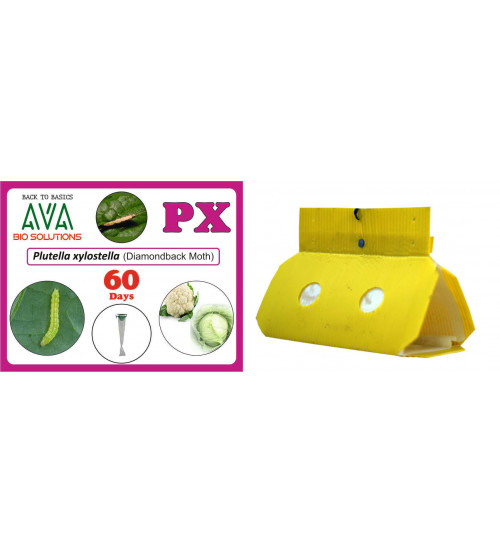
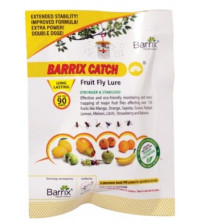
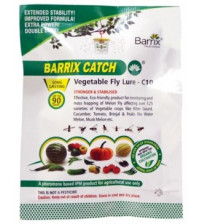
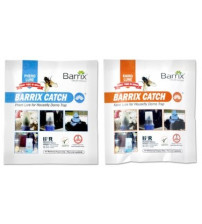
-202x224.png)
-202x224.png)
-202x224.png)
-202x224.png)
-202x224.png)
-202x224.png)
-202x224.png)
-202x224.png)
-202x224.png)
-202x224.png)
-202x224.png)
-202x224.png)
-202x224.png)
-202x224.png)
-202x224.png)
-202x224.png)
-202x224.png)
 Turning Point/Pheromone-trap-Diamond-Black-moth-DBM-Lure-Plutella-Xycostella-Funnel-trap-chipku-01-Copy(400)-202x224.png)
 Turning Point/1_Lucinodes-Orbonalis-Brinjal-fruit-and-shoot-borer-lucin(400)-202x224.png)
 Turning Point/1-Pheromone-trap-Yellow-stem-borer-Rice(400)-202x224.png)
 Turning Point/1-Brinjal-fruit-and-shoot-borer-lucin-lure-Funnel-trap-chipku-01(400)-202x224.png)
 Turning Point/Spodoptera-Litura-1(400)-202x224.png)
 Turning Point/Pink-bollworm-01(400)-202x224.png)
 Turning Point/helicoverpa-01(400)-202x224.png)
 Turning Point/Helicoverpa Armigera-202x224.png)
 Turning Point/Fruit-fly(400)-202x224.png)
 Turning Point/MelonFly (400)-202x224.png)
 Turning Point/Brinjal Fruit Shoot Borer(400)-202x224.png)
 Turning Point/Pectinophora gossypiella(400)-202x224.png)
 Turning Point/Spodoptera Litura(400)-202x224.png)
 Turning Point/DBM(400)-202x224.png)
 Turning Point/Yellow Stem Borer(400)-202x224.png)
 Turning Point/Fruit-fly-Mac-phill-01(400)-202x224.png)
 Turning Point/Melon-Fly-eco-trap(400)-202x224.png)
 Turning Point/Melon-Fly-Mac-Phill(400)-202x224.png)
 Turning Point/Chipku-yellow-sticky-trap(400)-202x224.png)
 Turning Point/yst-A4(400)-202x224.png)
 Turning Point/Blue Sticky Trap-01(400)-202x224.png)
 Turning Point/chipku-gum(400)-202x224.png)
 Turning Point/CHipku-Gummy-bag(400)-202x224.png)
-202x224.png)
-202x224.png)
 Turning Point/2021/yellow-sticky-trap (400)-202x224.jpg)
 Turning Point/2021/rat-trap-01 (400)-202x224.jpg)
 Turning Point/2021/solar-trap-3 (400)-202x224.jpg)
 Turning Point/2021/fruit-fly-liquid-01 (400)-202x224.png)
 Turning Point/2021/RB-Lure-2 (400)-202x224.jpg)
 Turning Point/2021/Amish A (400)-202x224.jpg)
 Turning Point/2021/Bucket-Trap-With-RPW-Lure (400)-202x224.jpg)
